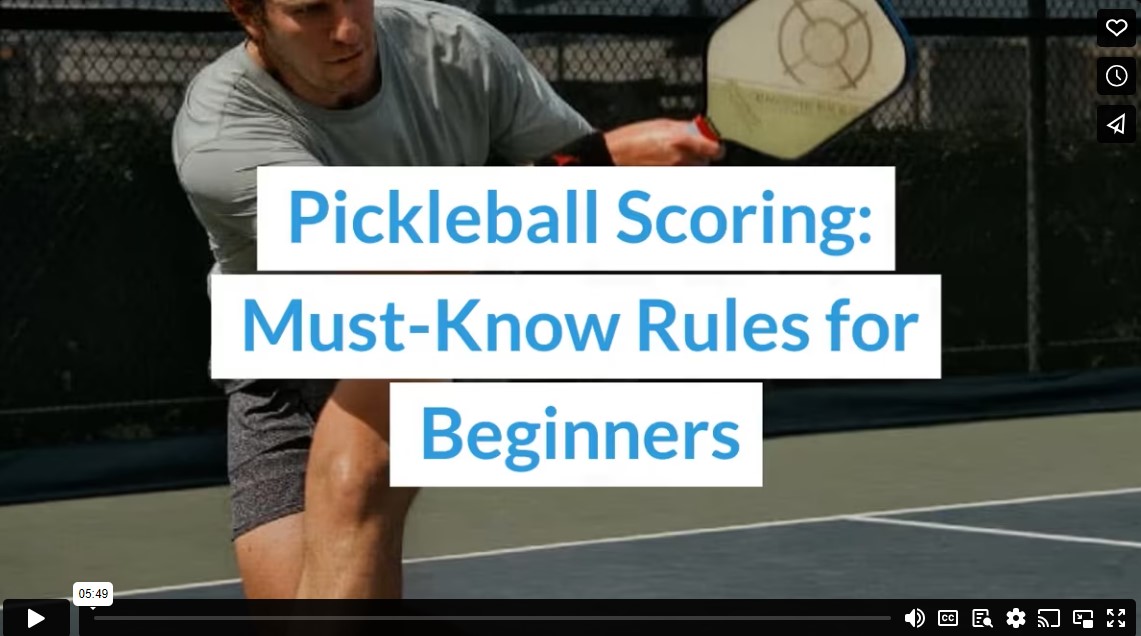All seasoned pickleballers know the joy of reaching 11. If you are new to the game, you may not know what that means. This guide will teach you how to keep score in pickleball. This skill may not feel as fun as mastering your dink shot or learning how to move smoothly into the kitchen, but it is critical to playing and winning a game of pickleball. Part of how to play pickleball for beginners is knowing how the scoring works. Here are the must-know rules of pickleball scoring every beginner needs to know.
Eleven is Heaven
A pickleball game continues until one team reaches 11. That’s the winning score in most cases, and the game ends at 11. However, you must also win by two points or more. That means that if the score is 10-10 and you win a point, 11-10 is not the end of the game. You keep playing until one team is ahead by two points. Then, you or your opponent can declare victory.
When teams are closely matched, they can sometimes trade points back and forth, pushing scores up into the twenties before one team wins two in a row, reaching that crucial two-point margin and claiming victory.
Serving Up Points
In pickleball, you can only score when your team is serving. You don’t get a point if you are on the receiving team and your opponent faults. In that situation, the serve rotates to the next player, with no points awarded on that play.
Let’s explain what that serve rotation looks like. At the start of a match, team A serves. If they win the point, they keep serving until Team B has a winning shot. Then, the serve goes to Player One on Team B, who keeps service until Team A wins the rally. The next server is Player Two from Team B. Then the serve goes back to Team A, first Player One, then Player Two.
This rotation continues until the end of the game. In other words, after the first serve of the match, each player on a team serves, then the serve goes to the other side. For the initial service, only one player from the first team–1A–serves, but after that, it is a set rotation of 1B, 2B, 1A, 2A, 1B, 2B, etc.
In singles, the serve switches sides each time the serving team faults. You keep serving until you lose a point. When you do, your opponent gets service and holds it until they fault.
Whether you are playing doubles or the less-common singles pickleball, you can only score points when you or your team have served.
Roll Call
“Five, seven, two!” That’s an example of a series of numbers that might be called out by a server in pickleball before they hit the ball. In casual games, it is part of the pickleball etiquette that you call the score before each point. In some tournaments, score-calling is part of the rules. Failure to do so correctly could result in a replay or even a fault.
This score announcement isn’t just a silly rule. If no one calls out the score, it is easy to forget where you are in the game. Also, if you announce the score before each point, you avoid disputes where you think you have six points and the other team believes you only have five. Everyone hears the score before each serve.
There is often no scoreboard or other means for tracking the score of your game. You have to keep track of it in your head. That’s why calling out the score before each point is essential to tracking your progress through the game.
Make it a habit to call out the score loudly so everyone on the court can hear it before you serve.
But What the Heck is “Five, Seven, Two?”
The score you call in doubles pickleball matches will have three numbers. The first two are easy. The first number is the score of the team serving the ball. The second is the score of the receiving team.
But what about that third number? Remember when we discussed the rotation of service? The second number helps everyone track whether a team is on their first server of the cycle or the second. If Team B wins a rally on Team A’s first serve, the right to serve goes to B. The first player on the B Team serves. That’s 1B in our rotation annotations above. The third number they’d call out is “one” because they are the first on their team to serve. When 2B serves, their third number would be “two.” Once that player loses the serve, the first player on Team A gets service, and their third number announced would be “one.”
This last number will always be one or two.
Let’s look at the score from the beginning of a game. Player 1, Team A serves. “0-0-1.” They win a point “1-0-1” and then another “2-0-1.” Then, their partner hits a ball that goes long and lands out of bounds. Since we are at the start of the match, only one player from the first team serves.
Service now goes to the other team. They announce “0-2-1” (Their score, their opponent’s score, and the acknowledgment that they are on their first server of the rotation). They win one point and call “1-2-1” before the next point. They fault by missing the ball entirely when they swing, as beginners sometimes do. The serve stays with their team but goes to their partner. “1-2-2.” If the partner’s serve leads to no points, the first team gets back the right to serve. “2-1-1.”
Notice that even when teams lost on their serve, the other team didn’t get a point added to their score. You can only score if your team is the server. Also, notice that the order of the first two numbers changes when service switches teams. Each player calls their score first.
This scoring pattern may sound complicated, but it follows a simple pattern. It’s always the serving team’s score, the receiving team’s score, and whether it is the first or second player serving.
Singling Up
In singles pickleball, there is no third number in the score. Since each team only has one player, keeping track of who is serving is unnecessary. You announce your score and your opponent’s score, in that order.
Just Play
Have you ever gotten a new board game, started reading the rules, and felt overwhelmed? You may have given up and figured you’d start playing and figure it out as you go. And suddenly, all those rules began to make sense. The game was easy, even if the written directions didn’t make it feel that way. These pickleball scoring rules can be the same way. It can sound like a lot, but once you hit the court, the pieces fall into place.
If you are playing with other, more experienced players, they can also help you if you need clarification. When in doubt, just hit the pickleball court and play. Sure, it’s fantastic to be the first to eleven, but the real victory is enjoying yourself, exercising, and having fun with friends.
Video
Infographic
Experienced players of pickleball know the feeling of excitement when scoring 11 points. But if you’re new to the game, you may not be familiar with how scoring works. Continue reading to learn about the guidelines that can help you understand the fundamental pickleball scoring rules in this infographic.





